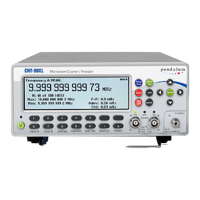Input Signaling Conditioning
else when attenuation can reduce the influence of
noise and interference. See the section dealing
with these matters at the end of this chapter.
Switch between AC coupling and DC coupling
by toggling the softkey
AC/DC.
AC coupling a symmetrical signal.
Use the AC coupling feature to eliminate un-
wanted DC signal components. Always use
AC coupling when the AC signal is superim-
posed on a DC voltage that is higher than the
trigger level setting range. However, we rec-
ommend AC coupling in many other measure-
ment situations as well.
When you measure symmetrical signals,
such as sine and square/triangle waves, AC
cou- pling filters out all DC components.
This means that a 0 V trigger level is always
cen- tered around the middle of the signal
wher
e triggering is most stable.
Missing trigger events due to AC coupling
of signal with varying duty cycle.
Signals with changing duty cycle or with a
very low or high duty cycle do require DC
coupling. Fig. 3-4 shows how pulses can be
missed, while Fig. 3-5shows that triggering
does not occur at all because the signal ampli-
tude and the hysteresis band are not centered.
NOTE: For explanation of the hysteresis band, see
page 4-3.
No triggering due to AC coupling of signal
with low duty cycle.
If you cannot obtain a stable reading, the sig-
nal-to-noise ratio (often designated S/N or
SNR) might be too low, probably less than 6 to
10 dB. Then you should use a filter. Certain
conditions call for special solutions like
highpass, bandpass or notch filters, but usually
the unwanted noise signals have higher
frequency than the signal you are interested in.
In that case you can utilize the built-in lowpass
filters. There are both analog and digital
filters, and they can also work together.
The menu choices after selecting FILTER.
The counter has analog LP filters of RC type,
one in each of the channels A and B, with a
cutoff frequency of approximately 100 kHz,
and a signal rejection of 20 dB at 1 MHz.
Accurate frequency measurements of noisy LF
signals (up to 200 kHz) can be made when the
noise components have significantly higher
frequencies than the fundamental signal.
USER MANUAL ● CNT 9x Series ● Rev.22 February 2020

